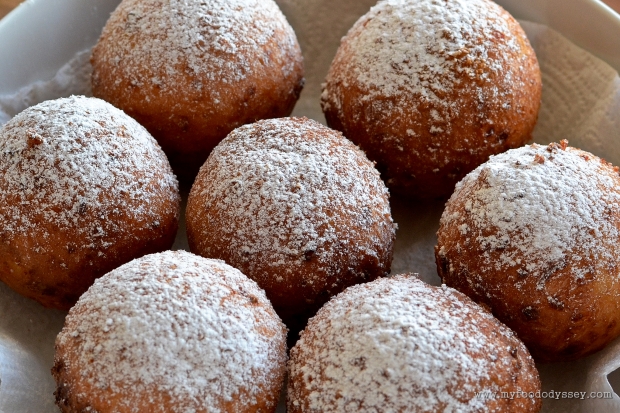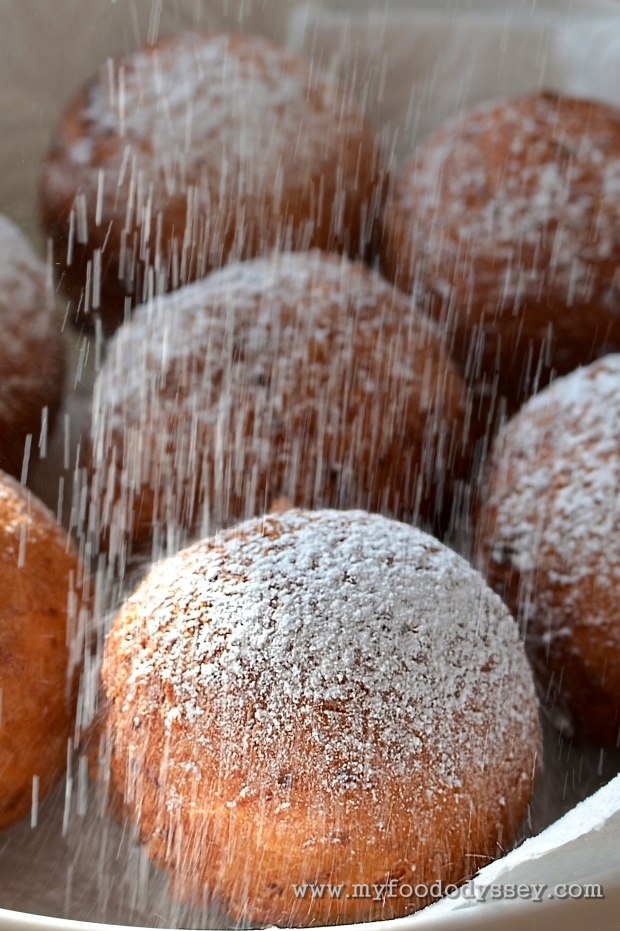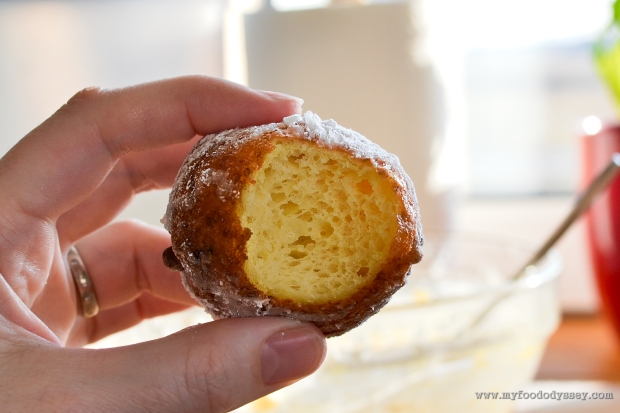Curd Cheese Doughnuts | Varškės Spurgos [Recipe]

When I first heard about curd cheese doughnuts I thought they sounded very strange. I had a vision of a chunk of cheddar sandwiched between two sides of a sugary ring doughnut, similar to a filled bagel. I’d been making cheesecake with cream cheese (which is really just curd cheese blended with cream) for years, so I don’t know how it was so difficult for me to get my head around. It wasn’t until I tasted one of the little fluffy delights freshly made at a farmers’ market here in Lithuania that I was sold on the idea.
Lithuanian curd cheese doughnuts are actually much easier to make than their American counterparts as they don’t use any yeast and so don’t require any time to rise. Instead, they get that wonderful airy centre from a combination of whisked egg and a little baking powder. The batter can be whipped up and ready for frying in less than 15 minutes.


The hardest part about making these doughnuts is probably going to be sourcing Lithuanian style curd cheese. Also known as quark in English, curd cheese comes in a variety of styles and can vary considerably from country to country. Lithuanian curd cheese is quite dry and fine. It is available in many countries in Baltic, Polish, Russian or Eastern European food stores. Look for “varškė” (Lithuanian), “twaróg” (Polish) or “biezpienu” (Latvian). It comes in a variety of packaging, from loose bags to little blocks a bit like Philadelphia cheese.

Recognising that true Lithuanian curd cheese might not be universally available, I set to finding some alternatives. I have often seen Lithuanian curd cheese translated to English as cottage cheese but really the two are nothing similar. Cottage cheese is usually covered in a milky liquid and the pieces are quite large. That said, the tastes are similar so I decided to test the recipe using cottage cheese, strained and mashed to resemble the consistency of Lithuanian curd cheese. The results were not good. While the flavour was similar, the batter was too wet and so the balls did not hold their shape. They were also quite heavy with grease. I tried to adjust the consistency with more flour but the resultant batter was gluey and the doughnuts tough and chewy. My conclusion – cottage cheese does not work as an alternative to Lithuanian curd cheese in these doughnuts.
I asked a group of Lithuanian cooks in the US what they used as alternatives to curd cheese and suggestions included farmer’s cheese, ricotta and Spanish queso fresco. Unfortunately, I couldn’t get my hands on any of these to test them, so I can’t vouch for the results.

Lithuanian doughnuts are much smaller than American doughnuts and are almost always round balls. They are so light and airy it is very hard to eat just one!
Curd Cheese Doughnuts | Varškės Spurgos
This recipe is no longer available online. For the full recipe and detailed, step-by-step instructions, please see my cookbook, available from just $2.99 here.
The book contains all of the most popular Lithuanian recipes including cepelinai (potato dumplings), šaltibarščiai (cold beet soup) and kugelis (potato pudding), plus stories from my life in Lithuania and colour photos of the stunning Lithuanian countryside.
To preview the book click here.


NEW! Lithuanian Cookbook:
You can now find all the Lithuanian recipes featured on this site in my new cookbook. This beautiful 77 page book also contains stunning photos of the Lithuanian countryside. Available from just $2.99 here.
.
More Lithuanian Recipes

LITHUANIAN KUGELIS | POTATO PUDDING:
A national dish of Lithuania, kugelis is a rich and hearty potato pudding. My version is made with chicken pieces, which steam inside the potato mixture, making them moist and delicious. (View recipe)

LITHUANIAN CEPELINAI | POTATO DUMPLINGS:
The national dish of Lithuania, cepelinai are hearty, nourishing and delicious. Written for cooks making cepelinai for the first time, this recipe includes step-by-step instructions with photos. (View recipe)

LITHUANIAN COLD BEET SOUP | ŠALTIBARŠČIAI:
This garishly pink soup is both light and nutritious, perfect for warm sunny days or for weekday lunches when your tummy needs a little TLC. (View recipe)

LITHUANIAN KOLDŪNAI | MEAT DUMPLINGS:
These delicious dumplings are the perfect comfort food – quick to cook, mild in flavour and served with a dollop of sour cream and a salty bacon and onion topping. (View recipe)

LITHUANIAN BALANDĖLIAI | CABBAGE ROLLS:
Another of Lithuania’s national dishes, these cabbage rolls are stuffed with seasoned ground pork and served with a creamy, tangy tomato sauce. Recipe includes step-by-step photos. (View recipe)
Like what you see? Then please subscribe to My Food Odyssey. For updates on my daily life you can follow me on Facebook, Twitter and Pinterest.
INGREDIENTS: For the dough: 400 g | 14 oz Lithuanian style curd cheese 50 g | 2 oz sugar 4 eggs
200 g | 7 oz plain flour (all-purpose flour) 1 tsp baking powder To fry: 1 litre | 1 quart sunflower oil
Note that you will need either a deep fat fryer or a sugar (candy) thermometer to perfectly fry your doughnuts. To serve: Icing sugar (powdered sugar), for dusting
METHOD: Place the curd cheese, sugar and eggs in a mixing bowl. Whisk together until smooth, pale and creamy – about 5 minutes. I use an electric hand mixer for this, but you could also use a stand mixer or even a hand whisk. Do not use the blade of a food processor as this will blend the ingredients but not incorporate the air required for a fluffy doughnut. Add the flour and baking powder and gently fold into the cheese mixture with a metal spoon. Attach a sugar (candy) thermometer to the side of a 2 litre (2 quart) saucepan, add the oil and heat over a high heat until the temperature reaches 170˚ C (340˚ F). If using a deep fat fryer ensure your oil is clean and has not previously been used for frying meat or other strong-tasting foods as this will alter the taste of your doughnuts. Taking 1 tablespoon of dough at a time, form the dough into small balls about the size of a golf ball or table tennis ball. This quantity of dough should make 20 40 g (1.5 oz) doughnuts. Use slightly damp hands to smooth the edges of the balls so that they form an even crust. When the oil has reached the required temperature, carefully drop your dough balls into the oil with a metal spoon. Don’t overfill the pan as the doughnuts will move about and expand while cooking. For this size saucepan I recommend no more than 4 doughnuts at a time. Cook the doughnuts for 7 minutes, ensuring the temperature of the oil does not fluctuate – adjust the heat as needed to maintain the temperature. Due to the baking powder, the doughnuts will “fizz” quite a bit and move around the pan. They will also turn themselves over several times during cooking, ensuring even cooking on both sides. (If you notice that any of your doughnuts are not flipping by themselves, just tip them over with a metal spoon.) When the doughnuts are cooked, carefully lift out of the oil with a metal spoon. Transfer to a plate lined with a paper towel to drain and cool. Continue to cook the doughnuts in batches until they are all cooked. Note that the mixture keeps well in the fridge for 1-2 days, so if you prefer you can keep some dough and make a fresh batch of doughnuts another day. Allow the doughnuts to cool for at least 20 minutes before eating. This ensures that the outside is dry and crisp and the inside light and fluffy. Just before serving, dust the doughnuts generously with powdered sugar. These doughnuts are best eaten on the day they are made. However, they will keep until the next day if stored in an airtight container once fully cooled. Ideally, don’t dust them with sugar before storing, but instead dust them just before serving. When the oil has fully cooled pour it back into the bottle (or better still, into a glass bottle), close the lid tightly and save for another use.
Trackbacks & Pingbacks
- Half-Sour Pickles | Rauginti Agurkai [Recipe] | My Food Odyssey
- Lithuanian Kugelis | Potato Pudding | My Food Odyssey
- Lithuanian Christmas Eve Biscuits | Kūčiukai [Recipe] | My Food Odyssey
- Lithuanian Koldūnai | Meat Dumplings [Recipe] | My Food Odyssey
- Lithuanian Cold Beet Soup | Šaltibarščiai [Recipe] | My Food Odyssey
- Lithuanian Sauerkraut | Rauginti Kopūstai [Recipe] | My Food Odyssey
- Lithuanian Cabbage Rolls | Balandėliai [Recipe] | My Food Odyssey
- Cepelinai for Beginners [Recipe] | My Food Odyssey

































My daughter is in 6th grade and was assigned a social studies project to make food from Lithuania- she made borscht soup and these wonderful donuts. We used ricotta cheese and they tasted great. Can’t compare to what they are supposed to taste like, but we would certainly make again. The borscht soup didn’t get the same review. Thanks for sharing your recipe we had fun making them. Like others we didn’t get the nice round shape but just dropped in the oil, but gave us fun shapes that the kids liked.
LikeLiked by 1 person
Hi Kelley! Thanks for your lovely comment. Yes, I can imagine the cold borscht wouldn’t go over too well with 6th graders (despite being pink!) Delighted to hear the enjoyed the donuts, though. I think the round shape is only possible with drier cheeses like farmers’ cheese or Lithuanian curd cheese. The taste should be just as good with ricotta, though. 🙂
LikeLike
Any additional tips, other than wetting hands, on making these nicely round in shape? I had to give up because the dough was just too sticky and just plop them into the oil allowing them to take whatever shape they may. Still came out yummy but now I need to work on the aesthetic aspect.
And, I don’t remember them being as crunchy as mine came out to be, is that normal? Found that otherwise the inside wouldn’t be cooked enough. Maybe it’s the oil temp I had (no thermometer so had to wing it)? Still yummy though!
By the way, I used Farmers Cheese in my recipe as that is the closest I could find here in the US. 😉
LikeLiked by 1 person
If they’re that wet and sticky I would suggest using 1 less egg in your batter to begin with. If the batter is then too dry (not sticky at all), whisk the forth egg in a cup and add it a tablespoon at a time. Wet hands should then give you nice smooth balls! On the crispiness, that can very a lot here based on house style. My husband and I both love them from one particular cafe where they are extra crispy and quite dark on the outside. It’s very difficult to regulate the temperature in a regular pot so you will always get a bit of variation. As long as you’re happy with the taste that’s fine!
LikeLike
hi, lithuanian with some varškės spurgų experience here, i think putting some oil on your hands is more or less the only way to get them to be smooth and and round, and yours were likely very crunchy just bc they werent smooth (though in my opinion it doesnt taste bad :D)
i realise the comment was made a while ago but i figured ill answer in case itll be useful to anyone else
LikeLike
I lived in Lithuania for a couple of years and I loved the varske spurga! My mom when she visited, loved them too! I usually got the ones at Ikis, etc., but our Vilnius school cafeteria has bigger ones which were good too. I looked for varske or its equivalent at a local Polish store here in S. California but they didn’t have it. But I did just find out a German deli in town does sell “quark” so I can go buy some! By the way, a linkage between the words can be ascertained because in German the word “quark” would be pronounced “kavark,”, so perhaps varske based on that.
LikeLiked by 1 person
Thanks Susan! I love discovering how things that at first seem quite different actually have a shared heritage. Hope you get your quark and get to make some delicious spurgos!
LikeLike
If you add some vodka to the batter then the doughnuts will not soak much of the oil and will be much healthier. Same with lithuanian potato pancakes, just add some vodka to the batter. No affect on the taste.
LikeLiked by 1 person
Great tip, Lina – thanks a million. I can’t get over the number of uses there are for vodka (beyond drinking it, that is!)
LikeLike
How much vodka would you recommend for this recipe?
LikeLike
Farmers cheese works the best, as June explained cottage cheese doesn’t work for this recipe, I’ve tried that substitute as well.
LikeLiked by 1 person
Thanks Rima. I was thinking Farmers’ cheese might work well.
LikeLike
NO “sunflower oil”. yes- coconut oils, lard.
http://raypeat.com/articles/articles/unsaturated-oils.shtml
LikeLiked by 1 person
Each to their own, I guess!
LikeLike
I find that using cottage cheese, or biezpiens in Latvian, gives all baked products better taste and texture compared to ricotta cheese. I simply started to make my own, the way I made it many years ago for my child. Heat 600ml of milk to boiling point and add 600ml buttermilk, stir and leave to cool down. Squeeze as much liquid as you like. The product will have the taste and texture as I remember back in Riga. Now I even have my own culture to make kefir – buttermilk. I make my own cottage cheese all the time and it is perfect fresh and for baking. I will try your recipe.
LikeLiked by 1 person
These look absolutely delicious! 🙂 I need to try these on the weekend!
LikeLiked by 1 person
Do – they’re easy and they’re SO yum!
LikeLike
They look so good. I definitely couldn’t eat just one! 🙂
LikeLiked by 1 person
It’s impossible, Cheryll!
LikeLiked by 1 person
Real curd cheese is food of the gods. I was a full grown legal adult before I found that out. Doughnuts from curd cheese? Sounds better than cheesecake. We did not know this was a thing and now we are both craving it. Thanks for sharing,
LikeLiked by 1 person
They are truly heavenly. Give them a go!
LikeLike
Hi June.
Those doughnuts, of course, are great, especially home-made ones, it’s a long time since i had opportunity to eat them, now usually i buy them at “iki”, but somehow those “industrially-made” ones constantly disappoint, although they are not bad 🙂
The best thing in this recipe for me was your translation 🙂 I have also learned the word “quark”. :).
Then i looked at the lithuanian wiki page of “Quark” article. And it is about the white curd cheese, it’s the same term you use, but it is the “sūris”, not “varškė”. Then i found the article (on Lith. wiki) on “varškė”. It is linked with english article – and it is “Curd”. Now, this one is the same one that i learned at school: “curd” is “varškė”, and “cheese” is “sūris”. And indeed, there is even a photo of genuine “varškė”… and it reads below that this is “Lithuanian curd cheese” 😦 . Which is obviously not cheese, it’s genuine “varškė”, and even the original image file description reads “varškė”. A bit confusing, no? 😀
I see you was focusing on “varškė” equivalents that could be found abroad, and it’s clear why – but if you was using “varškė” for doughnuts, why are you calling it “cheese” (“sūris”) then? 🙂 . A bit confusing to me 😀 .
And those 2 articles, “Quark” and “Curd”, i didn’t read them very very carefully but i have impression that it is almost about the same, no? Something like a description of synonyms?
In lithuanian it is very simple and clear: “varškė” is a raw material for cheese, and the “sūris” is a cheese made from its raw material 🙂 . To distinguish the white cheese from other kinds of cheese the respective attributes are added: white curd cheese is “varškės sūris”, “yellow” cheese is “fermentuotas sūris” (“fermented cheese”), dried cheese is “džiovintas sūris” and so on.
As soon as it comes to english translation, immediately various confusions begin 😀 .
BTW, don’t you make a “home-made” “varškė” ? It is easy-peasy and “varškė” then always is fresh, soft, and any amount of it can be made at the spot. Just a fresh milk is needed, it should be available at your neighbours (if you don’t have your own cow yet). Pasteurized milk (from the store) is not suitable. I’m almost sure that some of your neighbours make it at home, it is very common in rural areas.
LikeLiked by 1 person
By golly, you like to complicate things! It really isn’t complicated at all. Quark and curd cheese (and varške in Lithuanian) are synonyms – they are exactly the same thing. Whether called curd cheese or quark, several varieties exist and the consistency varies from country to country. I use the term varške in my post only to distinguish the Lithuanian style, which is quite dry and crumbly, from styles of curd cheese in other countries.
In English we do not have two separate words as in Lithuanian. Milk is separated into curds and whey and the curd element is the basis of all cheeses. When the curd is eaten in its raw, natural state it is called curd cheese.
I do make my own curd cheese at home when I have a supply of fresh, raw milk. I may include a recipe for this on the blog in the future for those who might like to make their own. However, many people would be put off making the doughnuts if they first had to make their own curd cheese. Also, as you’ve mentioned, you need fresh, raw milk which is not available in all countries.
Thanks as ever for your interesting comment – you keep me on my toes!
LikeLike
Aha, indeed, it’s simple 🙂 . Thanks 🙂 .
LikeLiked by 1 person
I wonder if they would work with chevre. Might give it a try when I can make cheese again.
LikeLiked by 1 person
I think it would work with chevre, Julie, provided it was nice and dry and well pureed. If you try it let me know how it went!
LikeLike
I had never heard of these. They look heavenly!
LikeLiked by 1 person
‘Ah Jeaus’!…they look and sound gorgeous. I’d love to give them a try but my fear is that if I get one of those deep-fat fryers then I’ll experiment with chicken, chips, beer battered fish and yes…even more doughnuts. It could be the ruin of me!
LikeLiked by 1 person
I hear you Gary! In that case I recommend the saucepan/sugar thermometer approach. When you have to set up the pot and pour in the oil each time it makes you think twice about deep frying. I actually think it’s a much healthier option, anyway. I had a deep fat fryer for years that I rarely used as they thought of that oil just sitting there between uses really put me off.
LikeLike
That icing-sugar-drizzle photo totally rocks 🙂
Droooooooooooooooooooooooooooooooool
LikeLiked by 1 person
Yeh, that photo makes me want to push my hand through the screen and grab one!
LikeLiked by 1 person
I shouldn’t be reading this while I’m hungry! Yum!!!
LikeLiked by 1 person
They look so much better than they sound. Comparable to a cheese danish perhaps
LikeLiked by 1 person
Yeh, the name is not appealing at all. The Lithuanian name is just a literal translation – I think they need to come up with a new one! For me a cheese Danish is more about a cheesy filling whereas here the cheese is baked into the dough. But they could be similar alright.
LikeLike
Thank you for this!
LikeLiked by 1 person
ah, now I need a plan to coax my mom to make me some or try the n-th time to make them myself with fingers crossed that maybe this time they’ll be perfect (even though i’ve failed the countless times before)
LikeLiked by 1 person
Go on, Asta – give them a go. They really can’t go wrong! If you do try them let me know how they turn out. 🙂
LikeLike
oh, but they can. I either burn them, or the dough is wrong, or… well, i think I better stick with plan A and talk to my mom. she’s a wiz with them, though she does not make then into round balls, but into somewhat flat ring ones cut with some wine glass (or any real thin rim cup), and then with it’s middle removed with even smaller glass. Yup, now that I’m drooling all over the place is high time to strategise some on how to get my hands on ’em any time soon 😀
LikeLiked by 1 person